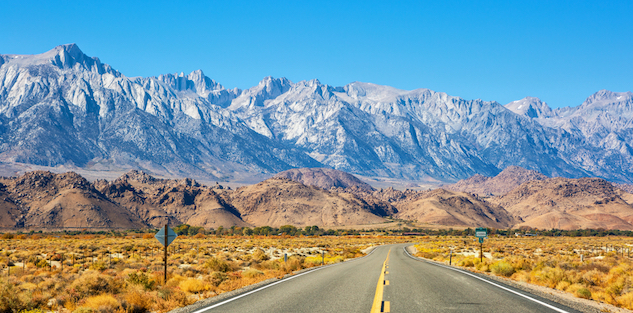News
Facing COVID-19 on California’s rural front
 A lonely road in Inyo County near Lone Pine, Calif., with the Sierra Nevada in the background. (Photo: Nella, via Shutterstock)
A lonely road in Inyo County near Lone Pine, Calif., with the Sierra Nevada in the background. (Photo: Nella, via Shutterstock)California’s most heavily populated counties are drawing the most attention as COVID-19 spikes and spreads, with Los Angeles reporting more than 140,000 cases and nearly 3,900 deaths since March.
But California’s rural counties also face immense challenges. And while their populations are less dense and the infection levels lower overall than the larger counties, the available health services often are scant.
“We have definitely seen an uptick in COVID cases, we went nearly two months without a positive case and since the reopening, we had 13 new cases. All of them were either people leaving the county and coming back, or tourists visiting,” said Jeff Griffiths, a member of the Inyo County board of supervisors.
Some rural counties are beginning to see trends of the first wave like their urban counterparts. And while estimates vary on the precise number of infections, the general trend clearly is upward.
“Whenever there is some kind of gathering or public opening, the potential for the virus to spread is massive.” — Ed Valenzuela.
Imperial County, for example, reported 993 COVID-19 cases per 100,000 of population, nearly triple the infection rate in Los Angeles County, while Lassen reported 638 per 100,000 population.
Siskiyou County has a population of 43,000 and is the fifth largest county in California in land area, stretching along the far northwest quadrant of the state to the Oregon line. Of those 43,000 people, five had been infected with COVID-19 in the first wave, according to local officials. That number jumped to 28 shortly after the economy was briefly reopened by Gov. Newsom in late June. The governor has since reinstated his closure policy, following spikes in the infection rate statewide.
Inyo County, off the east slope of the southern Sierra Nevada and including most of Death Valley, saw a similar reflection in their COVID-19 cases.
Siskiyou County and Inyo County both reported seeing a significant increase in their COVID-19 cases with infection rates increasing more than four times the initial rate.
“Whenever there is some kind of gathering or public opening, the potential for the virus to spread is massive,” said Ed Valenzuela, vice president of the California State Association of Counties and a member of the Siskiyou County board of supervisors.
“A lot of rural counties in California are tourist focused economies, so all it takes is one asymptomatic person to bring it into the community for it to infect the county,” he said.
While the numbers of COVID-19 patients in these counties appear relatively low and manageable, a rapid increase of cases could be devastating to the limited capabilities of each county’s health care systems, locals say.
“We have two hospitals across the 10,000 square miles of Inyo county, with only a handful of ICU beds.” — Jeff Griffiths
The rural counties’ economies also face deep risks because of the pandemic.
“We had one death from the virus and I do not want to downplay that, but the initial issue was with the economic side of things and the concerns about the limited healthcare systems that we have up here,” Griffiths said.
“We have two hospitals across the 10,000 square miles of Inyo county, with only a handful of ICU beds. It’s still a concern given the spike in cases recently, and if Inyo county were to see a dramatic rise in cases now, our healthcare system could easily be overwhelmed,” he said.
The immediate impact of COVID for rural counties was on the economy, since the virus had minimally infected local residents. The concerns of the locals in Siskiyou and Inyo are now about state funding and support. There are few pockets of funds to tap and the rural counties find themselves in a precarious position, Valenzuela noted.
“There is no budget dust in a rural county, it’s all allocated and if something happens, you’re taking it from someplace,” he added.
Inyo and Siskiyou counties have both reported to be promoting and enforcing strict COVID-19 protocol for all people entering or leaving their respective counties.
The method used by both counties is a direct line of clear communications relating to public expectations. “We need to be a safe community and we try to extend that message to our tourists that if they are visiting our county, that they are expected to adhere to social distancing and mask protocol.” Griffiths said.
“We’re confident with our track and trace capabilities, at the current level of COVID activity in Inyo, we can find and test all the people who could have come into contact with the virus, so in the immediate sense it’s not a concern, but a spike in cases could be devastating,” Griffiths added.
—
Ed’s Note: Chase Whitaker is a Capitol Weekly intern from UC Santa Barbara. The state’s coronavirus-related services page can be seen here. The Web sites of the Regional Council of Rural Counties and the County Supervisors Association of California can be seen here and here. The L.A. Times’ coronavirus tracker is available here.
Want to see more stories like this? Sign up for The Roundup, the free daily newsletter about California politics from the editors of Capitol Weekly. Stay up to date on the news you need to know.
Sign up below, then look for a confirmation email in your inbox.

Leave a Reply